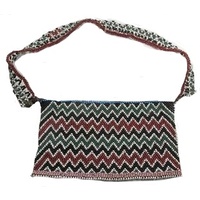[Source - Chloe Rushovich for FHYA, 2020, using material provided by Nessa Leibhammer and Rachel Hand: The Five Hundred Year Archive commissioned Nessa Leibhammer to make a selection of material relating to the 500 years preceding the advent of European colonialism in the region that is now known as KwaZulu-Natal and its surrounding areas from the Museum of Archaeology and Anthropology at the University of Cambridge. Leibhammer's selection of these objects was made on the following criteria: objects had to have been made in the 19th or early 20th centuries and had to have come from the KwaZulu-Natal region. Leibhammer also made sure to select a range of donors that included anthropologists, female collectors, and military or colonial officials. She ensured that the selection included a range of genre, such as carved wooden objects, metal and beadwork items. She also selected objects where she knew of the existence of similar objects in other collections that were likely to throw light on the objects at MAA. She thus relied in part on her own knowledge of the field and in part on information gleaned from the MAA accession records and assistance from Rachel Hand, the Collections Manager for the Anthropology at the Museum.
Leibhammer and Hand searched the MAA online database for all the items in the MAA collection that were labelled 'Zulu'; 'Natal'; 'Zululand'; 'KwaZulu-Natal'; and the term at the time for the inhabitants of southern Natal and the Northern Cape, 'Kaffir'. Hand found the relevant material in MAA's three stores. Leibhammer then manually combed through the Southern African card drawer and photographed the related catalogue cards, Accession Registers, and Annual Reports in order to make their selection. The FHYA is also concerned with the archival material associated with historical objects, such as notes, catalogue cards, labels, accession registers, and annual reports. This material formed part of Leibhammer's selection. MAA used catalogue cards to add additional object information from the very first accessions back in 1884 and replacement cards were made if the original was lost- usually using both different pens, and terms. Original sale or collector labels were sometimes stuck to the cards to add biographical layers of information, as well as letters, and, later, photographs. Staff and sometimes visitors, would add comments on provenances, measurements and locations over time. The FHYA organized all of this material into 'series', with each series being named after the primary collector of the material.]



Contributions